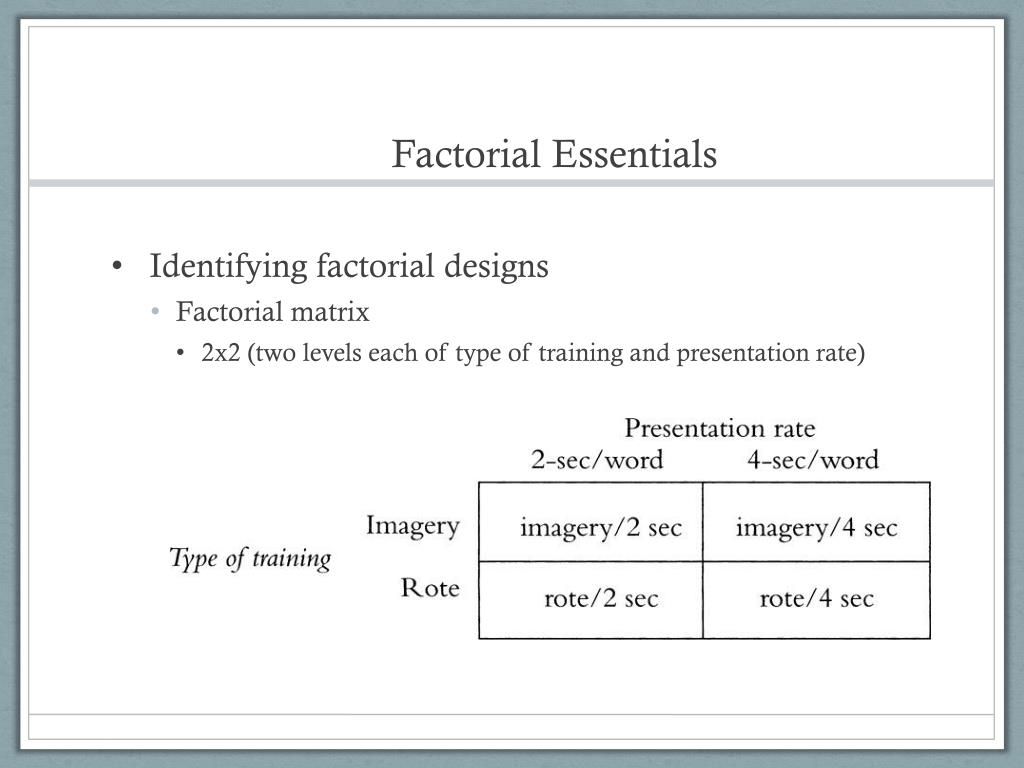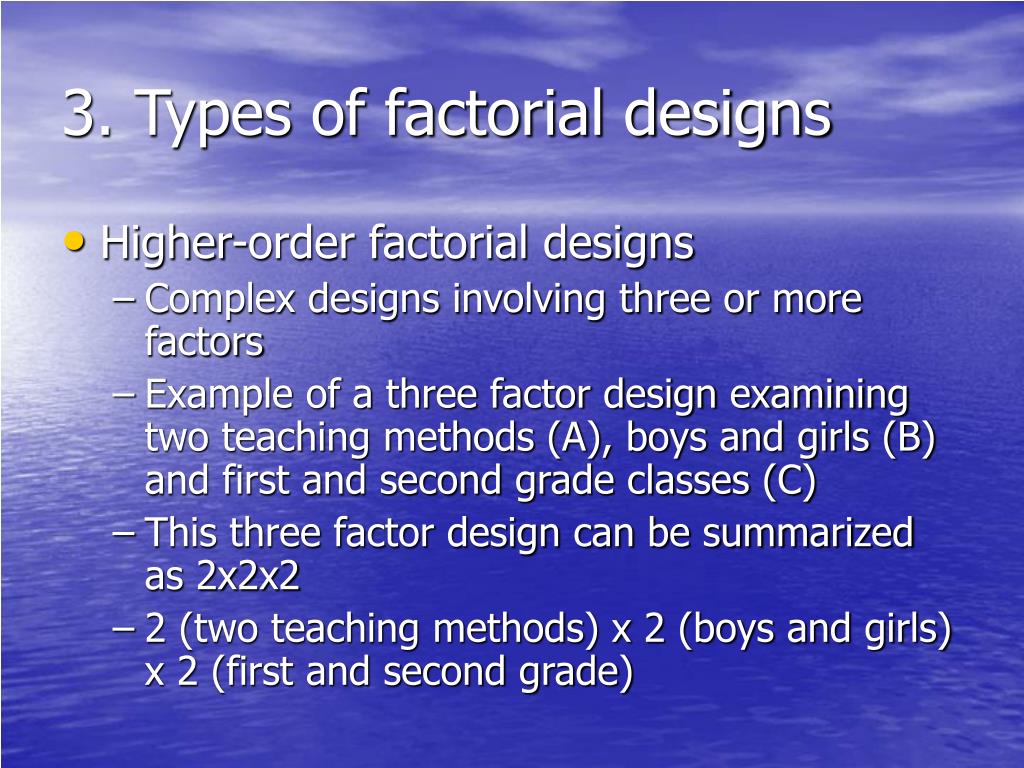Table Of Content

However, these two experiments would not have provided the same level of precision, nor the ability to test for interactions. The simplest way to understand a main effect is to pretend that the other independent variables do not exist. If you do this, then you simply have a single-factor design, and you are asking whether that single factor caused change in the measurement. For a 2x2 experiment, you do this twice, once for each independent variable.
Types of Factorial Designs
Transformations towards the bottom of the list are stronger in how they shrink large values more than they shrink small values that are represented on the plot. This pattern of the residuals is one clue to get you to be thinking about the type of transformations you would select. Residuals versus the plot of the fitted values in the upper right-hand corner has now a very distinct pattern.
5.1. Correlational Studies With Factorial Designs¶
As expected, we the average height is 6 inches taller when the subjects wear a hat vs. do not wear a hat. So, the main effect of wearing hats is to add 1 inch to a person’s height. As expected, we see that the average height is 1 inch taller when subjects wear shoes vs. do not wear shoes. So, the main effect of wearing shoes is to add 1 inch to a person’s height. The authors, other than Dr. Loh, have received no direct or indirect funding from, nor do they have a connection with, the tobacco, alcohol, pharmaceutical or gaming industries or anybody substantially funded by one of these organizations.
3.4. What makes a people hangry?¶
In this regard, “off” conditions (connoting a no-treatment control condition as one level of a factor) have certain advantages. They are relatively easy to implement, they do not add burden to the participants, and they should maximize sensitivity to experimental effects (versus a low-treatment control). Of course, less intensive (versus no-treatment) control conditions might be used for substantive reasons or because they ensure that every participant gets at least some treatment. Each factor is an independent variable, whilst the level is the subdivision of a factor. Assuming that we are designing an experiment with two factors, a 2 x 2 would mean two levels for each, whereas a 2 x 4 would mean two subdivisions for one factor and four for the other.
Basic Elements of RCT and Factorial Designs
The researchers note that the effects of the memory drug are more pronounced with the simple memory tasks, but not as apparent when it comes to the complex tasks. In this 3×2 factorial design, there is an interaction effect between the drug dosage and the complexity of the memory task. The combined main effects are significant as seen in the combined summary table. And the individual terms, B, C, D, BC and BD, are all significant, just as shown on the normal probability plot above.
Both of these graphs only contain one main effect, since only dose has an effect the percentage of seizures. Whereas, graphs three and four have two main effects, since dose and age both have an effect on the percentage of seizures. Because factorial design can lead to a large number of trials, which can become expensive and time-consuming, factorial design is best used for a small number of variables with few states (1 to 3). Factorial design works well when interactions between variables are strong and important and where every variable contributes significantly. When the factors are continuous, two-level factorial designs assume that the effects are linear.
Agricultural science, with a need for field-testing, often uses factorial designs to test the effect of variables on crops. In such large-scale studies, it is difficult and impractical to isolate and test each variable individually. Social researchers often use factorial designs to assess the effects of educational methods, whilst taking into account the influence of socio-economic factors and background. In these designs we will refer to the levels as high and low, +1 and -1, to denote the high and the low level of each factor. In most cases the levels are quantitative, although they don't have to be. Sometimes they are qualitative, such as gender, or two types of variety, brand or process.
Effects and Interaction Plots
Microwave-assisted hydrogen peroxide digestion followed by ICP-OES for determination of metals in selected fuel oils ... - Nature.com
Microwave-assisted hydrogen peroxide digestion followed by ICP-OES for determination of metals in selected fuel oils ....
Posted: Mon, 29 Jan 2024 08:00:00 GMT [source]
That is, the levels of each independent variable are each manipulated across the levels of the other indpendent variable. In other words, we manipulate whether switch #1 is up or down when switch #2 is up, and when switch numebr #2 is down. Another term for this property of factorial designs is “fully-crossed”. Factorial designs can pose challenges, but they offer important advantages that can offset such challenges. Of course, there is increased efficiency as investigators can screen more components at a reduced expenditure of resources.
& 4. Measure Performance to Find an Effect
This is a secondary consideration that should be taken into account after the primary considerations related to the percent of product defects. For each factor, you see that the residuals are more dispersed (higher variance) to the right than to the left. Overall, however, the residuals do not look too bad and the normal plot also does not look too bad. When we look at the p-values we find that A and C are significant but B and D are not. When you pick the correct transformation, you sometimes achieve constant variance and a simpler model.
This means that dosage (factor B) affects the percentage of seizures, while age (factor A) has no effect, which is also what was seen graphically. Frank Yates created an algorithm to easily find the total factorial effects in a 2n factorial that is easily programmable in Excel. While this algorithm is fairly straightforward, it is also quite tedious and is limited to 2n factorial designs. Thus, modern technology has allowed for this analysis to be done using statistical software programs through regression.
Are they actually separate experimental units or are they simply three measurements on the same experimental unit? If they are simply three measurements on the same piece of cloth that was all done in the same batch, for instance, then they are not really independent. If this is the case, then another way to look at this data would be to average those replications. In this case there is only 1 observation for each treatment, so that there would be no d.f. However, the way the problem is presented in the text, they appear to have been treated independently and thus are true replicates, leading to 36 d.f. If n is very small and your df for error are small, then this may be a critical issue.

The between-subjects design is conceptually simpler, avoids order/carryover effects, and minimizes the time and effort of each participant. The within-subjects design is more efficient for the researcher and controls extraneous participant variables. In sum, unless the investigator has access to clearly relevant data (preferably from factorial experiments) s/he should have strong concerns about how the elements in a treatment (the ICs) might interact. However, factorial experiments do not permit strong inferences about how well a particular grouping of components (occurring as levels of different factors) will work as an integrated treatment as compared to a control.
This is referred to as an interaction between the independent variables. Schnall and her colleagues, for example, observed an interaction between disgust and private body consciousness because the effect of disgust depended on whether participants were high or low in private body consciousness. As we will see, interactions are often among the most interesting results in psychological research. Ambitious, multifactor, factorial experiments designed to evaluate clinical ICs can and do work for the purpose of intervention component screening (Baker et al., 2016; Collins et al., 2016; Collins, Murphy, & Strecher, 2007; Fraser et al., 2014). We believe that their potential to yield unique data, and to do so efficiently, should make factorial screening experiments a core strategy in the process of developing effective treatments (Collins et al., 2016).

No comments:
Post a Comment